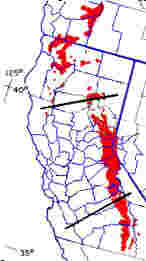
Range of Abies magnifica . Populations north of the line at 40°N are of Shasta red fir (3). |
Abies magnifica
A. Murray 1863
Common NamesCalifornia red fir, silvertip fir (2), Shasta red fir (1).
Taxonomic notes" Abies magnifica often exists in extensive high elevation stands in the Sierra Nevada; its close relative A. procera occurs in small mountaintop populations relatively isolated from one another. As expected for isolated populations, A. procera produces large interpopulation variation in morphology (5) and chemistry (Zavarin et al. 1978). Where the two species meet in southern Oregon and northern California, many populations are intermediate; these have been called A. magnifica var. shastensis Lemmon. The status of such intermediates is unsettled. They may be accepted as hybrids between A.magnifica and A.procera (6) or, alternatively, the paleontological record suggests that the two species may have originated from intermediates (Zavarin et al. 1978). Individuals from this region should be assigned to A.magnifica, A.procera , or A.magnifica × procera (Parker 1963), depending on the morphologic criteria selected to differentiate the species."An extensive study of this variation, as proposed by Zavarin et al. (1978), is warranted. Such a study should consider data from the type localities as a basis of comparison. Moreover, to evaluate this situation critically, one should first determine if any genetic exchange occurs between Abies lasiocarpa and A. procera that may complicate an evaluation" (1).
DescriptionTrees to 57 m tall and 250 cm dbh; "crown narrowly conic. Bark grayish, thin, with age thickening and becoming deeply furrowed with ridges being often 4 times wider than furrows, plates reddish. Branches ascending in upper crown, descending in lower crown; twigs opposite to whorled, light yellow to ± tan, reddish pubescent for 1-2 years. Buds hidden by leaves or exposed, usually dark brown, ovoid, small, not resinous or with resin drop near tip, apex rounded; basal scales short, broad, equilaterally triangular, densely pubescent, not resinous, margins entire to crenate, apex sharp-pointed. Leaves 2-3.7 cm × 2 mm, mostly 1-ranked, flexible, the proximal portion often appressed to twig for 2-3 mm (best seen on abaxial surface of twig), distal portion divergent; cross section flat, with or without weak groove adaxially toward leaf base, or cross section 3-4-sided on fertile branches; odor camphorlike; abaxial surface with 2 glaucous bands, each band with 4-5 stomatal rows; adaxial surface blue-green to silvery blue, with single glaucous band that may divide into 2 toward leaf base, band with (8)10(13) stomatal rows at midleaf; apex rounded or, on fertile branches, somewhat pointed; resin canals small, near margins and abaxial epidermal layer. Pollen cones at pollination ± purple or reddish brown. Seed cones oblong-cylindric, 15-20 × 7-10 cm, purple at first but becoming yellowish brown or greenish brown, sessile, apex round; scales ca. 3 × 4 cm, pubescent; bracts included to exserted and reflexed (Shasta red fir) over scales. Seeds 15 × 6 mm, body dark reddish brown; wing about as long as body, rose; cotyledons 7-8. 2 n =24" (1).
RangeUSA: Oregon, California and Nevada at 1400-2700 m in mixed conifer forests (1). See also (10).
Big TreeHeight 52.4 m, dbh 295 cm, in Yosemite National Park, CA; also, height 76.8 m, dbh 153 cm, in Sequoia National Park, CA (4).
OldestA citation of 518 years without supporting information; presumably a ring count (8).
Dendrochronology
Ethnobotany
ObservationsFine stands are said to occur in Sequoia and Kings Canyon National Parks (7).
Remarks
Citations(1) Hunt, Richard S. at the Flora of North America web site .(2) Peattie 1950 . (3) Burns & Honkala 1990 . (4) E-mail communication from Robert Van Pelt, who measured these trees; 18-Mar-1998. (5) Maze and Parker 1983 . (6) Liu 1971 . (7) Arno & Gyer 1973 . (8) Carder 1995 . (9) Hickman 1993 . (10) Robert S. Thompson, Katherine H. Anderson and Patrick J. Bartlein. 1999. Atlas of Relations Between Climatic Parameters and Distributions of Important Trees and Shrubs in North America. U.S. Geological Survey Professional Paper 1650 A&B. URL= http://greenwood.cr.usgs.gov/pub/ppapers/p1650-a/pages/conifers.html.
See also:
|
|
[ Abies ] [ Pinaceae ] [ home ]
This page is from the Gymnosperm Database
|